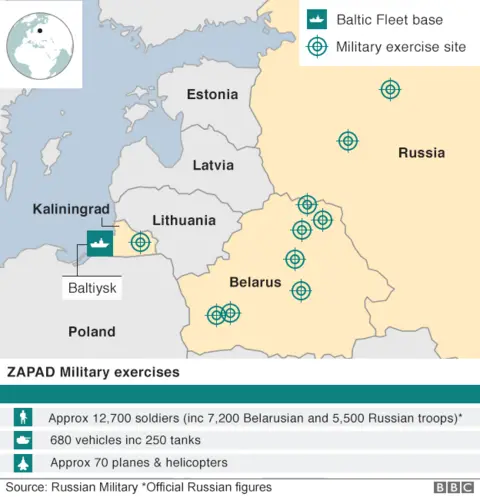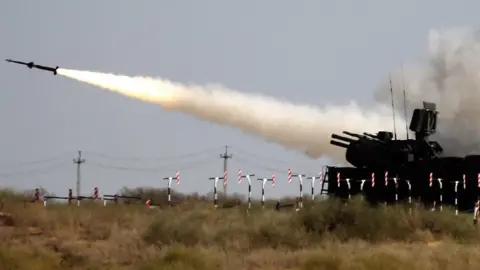Russian Zapad military exercise in Belarus raises tension
It is being billed as a military exercise, but when Russian and Belarusian forces start Zapad-2017 this week, many neighbouring countries will be looking on nervously.
Zapad-2017 ("West-2017") is a joint strategic-level exercise involving Russian and Belarusian military forces, expected to begin on 14 September in Russia's western military district Kaliningrad, and across Belarus.
It is scheduled to last about a week, but may well go on for longer. The exercise is part of a four-year rolling cycle of manoeuvres that focus each year on one broad region or "front" ("West", "Eastern", "Central" or "Caucasus"). This year's Zapad exercise though is drawing much greater attention than did its predecessor in 2013.
The context has changed significantly. Russia has seized and annexed Crimea; it has supported a separatist war in eastern Ukraine with weaponry, training and, for periods, its own combat units. Russia is thus seen by several Nato countries as much more threatening.

Ukrainian President Petro Poroshenko has described Russia's build-up for the exercise as "preparations for an offensive war on a continental scale". Ukrainian border defences, he said, are being bolstered.
He also pointed to the fact that in his view, Russia has form here, using the pretext of an exercise to mobilise and position forces to conduct offensive operations. President Poroshenko said he could not rule out the possibility that the drill "may be used as a smokescreen to create new Russian army assault groups to invade Ukrainian territory".
 EPA
EPAUnits on the move
Nato watchers and insiders do not necessarily share this concern about an all-out invasion of Ukraine.
Russia expert Keir Giles, a fellow at Chatham House think tank, acknowledges that "previous Russian exercises on this scale have prepositioned troops for undertaking military operations, against Georgia in 2008 and against Ukraine in 2014".
However, he says, "both of those moves were precipitated by an immediate political crisis - currently absent in Europe.
"And there have been plenty of other major Russian exercises in between," he says, "which did not end up with somebody getting invaded".
Nonetheless, the fear of a resurgent and more aggressive Russia is real enough. That is why, over the past year, Nato has sent small multi-national units to Poland and to each of the three Baltic republics to underline its deterrent message. And that is why this year's war games will be watched so closely.
Just how closely is a contentious issue. Russia, unlike Belarus, has been far more reluctant to invite Western observers in any number. This despite the fact that, as a member of the OSCE international security body, it is obliged to send out broad invitations if an exercise numbers more than 13,000 troops.
Mr Giles notes that, while Russia may be "content to see Europe alarmed at the prospect of Moscow throwing its military weight around", Belarus seeks instead to calm the situation. The siting of the exercise in ranges across the middle of the country - not near the Polish and Lithuanian borders - was a deliberate policy decision intended to reduce the chances of misinterpretation, or incidents when Russian troops and aircraft come close to Nato borders.
 AFP
AFPBelarus has been much more open towards international observers. Clearly satellites, airborne radars and other national intelligence collection measures will be used by Nato countries.
In addition, efforts are under way to mobilise concerned citizens in Belarus to observe military movements in their area and post them online for the benefit of non-government, open-source analysts and experts.
How many troops?
So just how big is this exercise and what will Western analysts and observers be watching for? Here assessments differ widely.
The Russians say some 12,700 troops will be involved in total, including a significant contingent from Belarus. (Notice this takes it below the 13,000 OSCE threshold.)
Western experts watching the preparations, especially the marshalling of railway flat-cars - the main way of moving heavy armoured formations to the exercise areas - say it will be considerably more.
 AFP
AFPSome estimates suggest that up to 80,000 troops could be involved, but since there are a range of drills, exercises and spot mobilisations it is hard to be precise about numbers.
Russia will be testing its capacity to contain and respond to some form of outside aggression and will be deploying units from different services: heavy armour; airborne troops; "spetsnaz" elite reconnaissance teams; and electronic warfare specialists.
The Baltic Fleet will be involved, as will units from the 14th Corps based in Kaliningrad. One point of interest may be the part played at the tactical and strategic levels of "information operations troops" - a relatively new formation in the Russian order of battle.
Indeed, while there may be much to learn about Russia's use of artillery, its capability in electronic warfare (already manifest in the fighting in Ukraine) and the growing importance of precision-guided munitions in Russia's thinking, it may be this information aspect that is most important. For beyond the troop movements, Zapad-2017 is part of a wider propaganda effort to influence and shape opinion in the West.
Atmosphere of suspicion
The US analyst Michael Kofman in a fascinating piece on the War on the Rocks website, describes Zapad as "a good window into the Russian mindset.
"For all the modernisation and transformation of the Russian armed forces," he writes, "in reality the Russian leadership is probably still afraid: afraid the United States will try to make a bid for Belarus, afraid of American technological and economic superiority, afraid the US seeks regime change in Moscow, and afraid Washington desires the complete fragmentation of Russian influence in its near abroad, or even worse, Russia itself."
"Zapad," he argues, "is the most coherent manifestation of these fears, and a threat from Moscow to the United States about what it might do if the worst should come to pass."
And what of those lingering fears in some quarters that this could be much more than just an exercise? Mr Giles remains unconvinced by much of the media hyperbole surrounding Zapad.
But he has this caution: "The time to watch troop deployments most closely," he says, "is likely to be after the exercise proper has ended."
The final day of Zapad is 20 September but, he notes, "Russian troops are only scheduled to leave Belarus by 30 September - after the observers have departed, and when the media interest will have died down. That will be the time to decide whether Zapad this year has in fact passed off peacefully."
